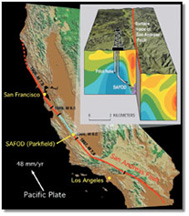 |
 'National Medals of Science' 'National Medals of Science'
|
 |
President Names Eight Elite Scientists and Engineers to Receive National Medals of Science
President Bush on Oct. 22 named eight of the nation's leading scientists and engineers to receive the 2002 National Medal of Science for work that spawned many advances in scientific theory and developments leading to new technologies. The presidential medal is the nationís highest honor for researchers who make major impacts in fields of science and engineering through career-long, ground-breaking achievements and on the individual disciplines for which the awards are given. The medal also recognizes contributions to innovation, industry or education. "The ideas and breakthroughs in fundamental science and engineering by these extraordinary pioneers have influenced thousands of other researchers," NSF director Rita Colwell said. "These amazing people represent overall close to four centuries worth of experience in research, teaching and leadership inside their fields and extending across many other disciplines as well."
More... (posted October 24, 2003) |
 |
|
NSF Grantees Awarded 2003 Nobel Prizes in
Economics, Physics, and Physiology or Medicine
The Royal Swedish Academy of Sciences on Oct. 7 announced
Anthony Leggett, physics professor at the University of Illinois,
Urbana-Champaign, was awarded the 2003 Nobel Prize in Physics for
groundbreaking work in explaining the behavior of atoms in superfluids.
NSF ďis proud to have supported his research over the past 20 years,"
said NSF Director Rita R. Colwell in a statement shortly after the
award was announced. On Oct. 8, Colwell congratulated Dr. Robert
F. Engle, of New York University, and Dr. Clive W. Granger, of University
of California-San Diego, for their selection as co-winners of the
2003 Nobel Prize for Economics, noting NSF "has supported the research
of both of these distinguished economists for the past quarter century."
On Oct. 6, Colwell and NSF Deputy Director Joseph Bordogna congratulated
the 2003 Nobel Laureate in physiology or medicine, Professor Paul
Lauterbur, on the faculty of the University of Illinois, Urbana-Champaign
and also a recipient of NSF support.
(posted October 20, 2003)
Statement on
Drs. Engle and Granger
Statement on Dr. Leggett
Statement on Dr. Lauterbur
|
 |
|
 |
EarthScope will drill directly into the earthquake zone of the San Andreas Fault to measure changes in rock properties before, during, and after earthquakes. Linked to other EarthScope measurements at the surface, these direct observations will, for the first time, monitor how an active fault and responds to regional and local changes in stress.
Credit: EarthScope
|
NSF
Awards $219 Million Over Five Years for Earthscope Project: Far-Reaching
Geosciences Effort to Understand the North American Continent
When President Thomas Jefferson sent Lewis and Clark
across the nation to explore the American West in 1803, the world
knew little about western America. The discoveries the expedition
made, many unprecedented, led us to appreciate our nation's natural
resources, settle the West, and eventually, to establish national
parks. Now, exactly two centuries later, NSF has funded a latter-day
Lewis and Clark expedition: EarthScope, a scientific exploration
of the structure and evolution of the North American continent,
and the physical processes controlling its earthquakes and volcanic
eruptions. This time, however, instead of toting sextants and compasses
to map the surface, scientists will bring seismometers, state-of-the-art
drilling equipment, satellites and GPS receivers to map Earth's
interior.
More... (posted
October 20, 2003) |
 |
|
NSF
Grants Establish New Centers For Learning and Teaching at Missouri,
Rutgers, Berkeley
NSF recently announced the award of 5-year, $2 million annual grants
to the University of Missouri, Rutgers, and the University of California-
Berkeley to establish new K-12 Centers for Learning and Teaching.
The grants are to build current and future leaders in science, technology,
engineering and mathematics education through the schools' graduate
programs; improve elementary and secondary education practice, and
provide opportunities for research. The foundation supports Centers
for Learning and Teaching that specialize in one of three categories:
Issues in Elementary and Secondary Education, Issues in Higher Education
and Nanotechnology Education. Today's awards raise to 13 the number
of centers focused on elementary and secondary issues.
More... (posted
October 20, 2003) |
 |
|
 |
The eSkeletons digital library lets students examine and compare the skeletons of a human, gorilla, baboon and other species through high-resolution annotated photos and 3-D digital models. The collection will soon provide data in a format that will allow users to build replicas of the bones. This image shows a baboon skull with the frontal bone highlighted and a 3-D model of the skull.
Credit: eSkeletons Project, University of Texas, Austin |
Discover the Physical
World Through the National Science Digital Library
The National Science Digital Library (NSDL) is building the collections
and services of an online digital library for science, technology,
engineering and mathematics education for all ages. Supported by
NSF, the NSDL provides access to materials and methods that reveal
the nature of the physical universe and a way for humans to discover
and understand it. Among the collections currently accessible or
being brought online through the main NSDL portal:
- The eSkeletons project at The University of Texas at Austin
lets students and teachers view and compare the bones of a human,
gorilla, baboon as well as other species and gather information
about them from the Texas anthropology departmentís osteology
database.
- The sounds of Psittacidae, the parrot family, are
among the thousands of animals whose sounds have been recorded
and stored in the Macaulay Library at the Cornell Lab of Ornithology.
The Macaulay Library houses the world's largest collection of
video and sound recordings of animal behavior, and a new NSDL
project is supporting the library in its efforts to make its archive
available online for research, education and conservation uses.
More... (October
20, 2003)
|
 |
| |


|

